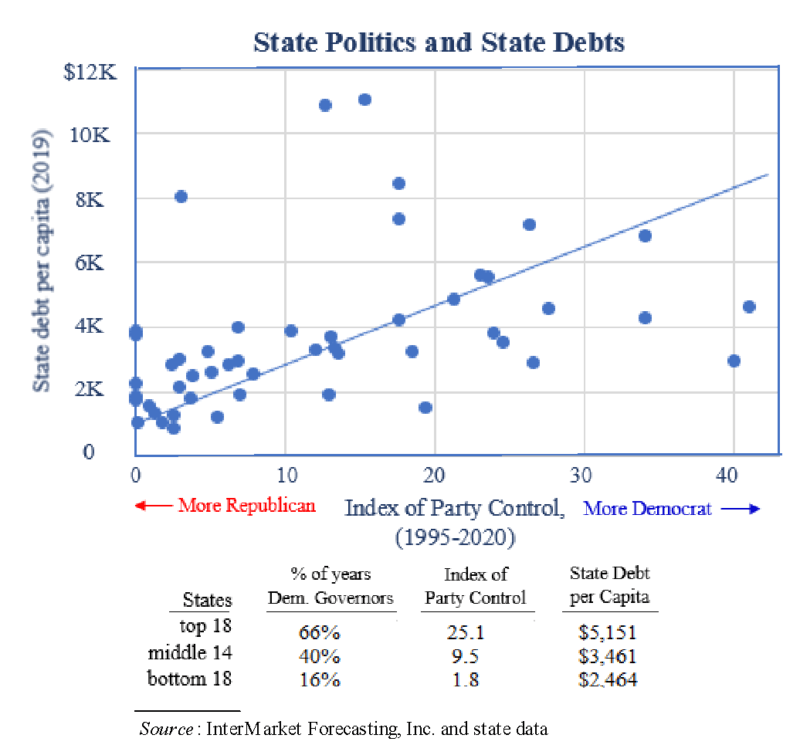The Plan to Have Red States Bail Out Blue States

According to the Tax Foundation, the proposed HEROES Act – which is now being pushed heavily by Speaker of the House Nancy Pelosi (D-CA) – would provide roughly $1 trillion in aid to state and local governments, or one third of the Act’s total planned outlays. There is no good reason to believe the Act will “stimulate” the economy, any more than did the $2.3 trillion CARES Act (enacted March 27th), but it’s worth examining the extent to which the aid provision might redistribute wealth, set a bad precedent, and incentivize profligate fiscal behavior in the future.
The nearby exhibit relates partisan control of the fifty American states over the past twenty-five years (1995-2020) to current state debt (per capita). My key premise is that current indebtedness largely embodies cumulative budget performance over recent decades; greater indebtedness reflects the long-term dominance of chronic deficit-spenders while lesser indebtedness reflects the dominance of budget-balancers. Next, we can ask whether party control relates to indebtedness.

Measuring party control in the states can be tricky. To avoid placing too much weight (i.e., praise or blame, for current state indebtedness) on the politics of only recent incumbents, I use twenty-five years of data (1995-2020). First, I calculate the percentage of years in which states had Democratic or Republican governors. Next, I measure the partisan make-up of state legislatures during this time. Finally, I relate the two measures and created a simple “Index of Party Control” (IPC). The higher the IPC, the more a state has been governed by Democrats over the past quarter century; the lower the IPC, the more a state has been governed by Republicans during this time.
Armed with two decent measures of current state indebtedness and long-term partisan control, we can then relate them. My exhibit reveals a distinct, positive relationship between state politics and debts. The more a state was governed by Democrats in recent decades, the larger is its current debt burden; the more it was governed by Republicans, the smaller is its current debt load.
The exhibit shows how the top eighteen states with the highest IPC have had an average index of 25.1, have been ruled by Democratic governors 66% of the time since 1995, and now suffer a high average per capita debt ($5,151). In contrast, the bottom eighteen states with the lowest IPC have had an average index of just 1.8, have been ruled by Republican governors 84% of the time, and now enjoy an average per capita debt of only $2,464 (less than half the level of the high-debt states).
Should the HEROES Act be enacted with the provision of $1 trillion in state aid, and if, as is likely, it directs relatively more aid to states with greater needs (indebtedness), it would be akin to red (Republican) states bailing out blue (Democratic) states. Partisanship aside, the aid provision would punish those citizens and officials who have been fiscally responsible over the years, while rewarding those who have been fiscally reckless. Not only would the policy be unjust, but in setting so terrible a precedent, it would only incentivize still further fiscally reckless behavior.
In today’s fiscally profligate age, public officials who budget and borrow responsibly might be considered heroes; what a shame if the HEROES Act were passed and treated them as suckers.










